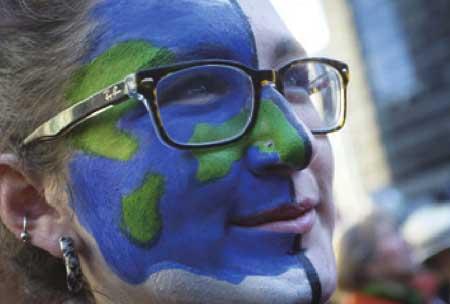Solid Work to Be Done
2016-02-24ByDengYaqing
By Deng Yaqing


The possibly catastrophic consequences of a warming atmosphere motivate government officials from countries all over the world to gather together every year and negotiate over fighting global climate change. After a legally binding climate deal was reached in Paris among nearly 200 nations last year, the world is now on the way to making the agreement become reality.
The 22nd Session of the Conference of the Parties to the UN Framework Convention on Climate Change (UNFCCC), formally known as the COP22, is taking place from November 7 to 18 in Marrakech, Morocco. “Its the first climate change conference after the Paris agreement came into force, [so] it is deemed as a chance to put the unprecedented deal into practice,” said Xie Zhenhua, Chinas special representative on climate change affairs.
First of all, efforts will be made to intensify actions fighting climate change before 2020.“Although representatives struck a deal last year, the emissions targets laid out in the Kyoto Protocol Amendment have not yet been real- ized. While the Paris agreement prescribes actions that curb climate change after 2020, the Kyoto Protocol Amendment targets actions before 2020, and both of them are important,”said Yang Fuqiang, a senior climate, energy and environment adviser to the China Program of the Natural Resources Defense Council, a notfor-profit international environmental advocacy group.
Besides that, representatives will make detailed arrangements and work out a timetable and roadmap for the implementation of the Paris agreement, gain knowledge about the status of all contracting countries actions related to carrying out their intended nationally determined contributions (INDCs), and make plans to achieve green and low-carbon development. They will also confirm that the promises made by developed countries concerning necessary capital, technology and capacity-building support for developing countries will be realized.
“At the Marrakech conference, it should be made clear how much money developed countries have provided to the Green Climate Fund, where the money has gone, and what results the spending has yielded,” Xie said. The Green Climate Fund, created in 2010, is a financial mechanism within the framework of the UNFCCC to assist low-emission and climateresilient development.
Due to the limited time, a lot of topics werent talked through in Paris, such as technology transfers, capacity building, mitigation and adaptation and financial support. In Marrakech, representatives will give more time to discussing these topics, according to Yang.
Aiming high
The Chinese Government attaches great significance to tackling climate change, said Xie, noting that the nation takes the issue as a great opportunity to accelerate the transformation of its economic development model and carry out economic restructuring.
According to statistics from Chinas Policies and Actions on Climate Change (2016) report released on November 1, the countrys carbon intensity was reduced by 20 percent during the 12th Five-Year Plan (2011-15) period, outperforming the target of 17 percent; the share of non-fossil fuels in its primary energy consumption in 2015 reached 12 percent, above the target of 11.4 percent; and forest growing stock climbed to 15.14 billion square meters, surpassing the target to be achieved by 2020.
Furthermore, in the first three quarters of 2016, Chinas energy consumption intensity and carbon intensity further dropped 5.2 percent and roughly 6 percent respectively, exceeding this years annual targets of 3.4 percent and 3.9 percent.
To score so highly in energy conservation and carbon emissions reduction, China has endeavored to optimize its industrial structure, enhance energy efficiency and improve its energy structure, Xie explained.
According to the report, service industries now account for 52.8 percent of Chinas economy, up 1.6 percentage points year on year; the growth of hi-tech and strategic emerging industries outpaced that of industrial enterprises with principal business revenue of more than 20 million yuan ($2.95 million) a year by 4.6 and 4.8 percentage points respectively.
“In energy conservation and energy efficiency improvement, the country has taken measures targeting the industrial sector, transportation and public facilities,” Xie said.
In addition to a series of projects featuring energy conservation and emissions reduction, China has also enhanced relevant economic policies such as improving the low-carbon pricing mechanism, finalizing the financial and taxation incentive mechanism, and developing green finance.
“Considering the current strong momentum, the chance is strong for China to realize the pledges made in its INDCs for 2030. Most experts in the energy realm believe the country can even fulfill the targets in its INDCs in 2025 or earlier,” Yang said.
By September, a total of 120 million tons of carbon dioxide, worth more than 3.2 billion yuan ($473 million), had been traded in Chinas seven pilot carbon-trading markets. In addition, the Chinese Government had contributed 580 million yuan ($86 million) to provide small island states, least developed countries and some African nations with material assistance, launched 10 low-carbon demonstration areas and 100 climate change mitigation and adaptation projects, and trained 1,000 experts and officials from other developing countries in tackling climate change.
“Predating the Paris agreement, China issued an array of joint announcements with the United States, France, the EU, India and Brazil, which allowed it to reach consensus with major countries on divergent points and find solutions,” said Xie, who believes those efforts facilitated the birth of the historic agreement.
“Compared to the 2009 Copenhagen conference, preparations for the Paris conference were sufficient, and Chinas efforts in strengthening coordination and communication laid a foundation for the conclusion of the Paris agreement,” said Li Shuo, Senior Climate and Energy Policy Officer for Greenpeace East Asia.
Implementing the agreement
The Paris agreement comprises 29 items encompassing targets in finance and technology, capacity building, transparency, mitigation and adaptation. To shield the world from potential risks arising from climate change, the agreement requires countries to work together to limit the increase in average temperatures worldwide to levels no more than 2 degrees Celsius above pre-industrial levels and to pursue efforts to limit the increases to 1.5 degrees Celsius.
“All participants in the Paris agreement have shown great sincerity and made great efforts. At the Marrakech conference, the main theme is how to carry it out and how to assess and measure the implementation,” Li said.
“While the worlds largest developing country can surely realize the promises it made for the period before 2020, some developed countries are reluctant to commit themselves to fight climate change before 2020. [This is demonstrated by] the United States refusal to sign the Kyoto Protocol, as well as Canadas withdrawal and Japans reluctance to join the protocols second commitment period,” Li said.
At the 2009 Copenhagen conference, developed countries pledged to provide $100 billion annually by 2020 to the developing world. Despite continual urging by members of the international community, progress in keeping that promise has remained lackluster.
According to a report released by the Organization for Economic Cooperation and Development (OECD), the aggregate volume of public and private climate finance mobilized by developed countries for developing countries reached $62 billion in 2014, almost 20 percent more than the $52 billion provided in 2013.
Developing countries need to decide whether this funding is in line with the UNFCCC requirements. At the same time, donor countries should make public how much they have given and to whom, while recipient states should declare from where they have received money and for what they will use it, Xie said, adding that a transparent mechanism needs to be established to track the funds.
“Funding is a major pending issue. A straightforward map and timetable is what developing countries yearn for, and heated debates will revolve around this topic during the Marrakech conference,” Li predicted.
However, meeting all of the current national INDC targets would still result in an average global temperature increase of around 2.7 degrees Celsius by 2100, falling short of the 2-degree-Celsius goal, according to a report released by the International Energy Agency, an inter-governmental organization established within the framework of the OECD.
To bridge the gap, countries have agreed to assess their implementation strategies and take stock of their efforts results every five years, starting from 2023. Following on from that, they will have to reinforce their actions every five years.
“The declining coal use in China and the energy transformation in the United States have undoubtedly helped ... [the two nations toward] achieving their INDC targets, but the results are limited. Therefore, countries need to seek new solutions rather than depending entirely on administrative means. For example, the United States should speed up its legislation on fighting climate change,” Li said.
“Its arduous work to close the gap between existing INDC targets and the 2-degree-Celsius goal before 2100. Therefore, calling on countries to boost their ambitions will become a major topic in the 2018 climate change conference,” Yang said.
